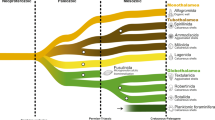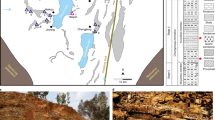Abstract
The first opening of the Bering Strait was an important palaeogeographical and biogeographical event for marine and terrestrial biotas in Asia and North America1,2,3, and an oceanographic event of global importance4,5,6. This event, however, has never been precisely dated, so it has not been accurately incorporated into models of global biogeography and oceanography. A recent find of the bivalve mollusc Astarte in southern Alaska is a clear signal that the strait had opened by at least the Late Miocene or earliest Pliocene epochs, because this genus otherwise dwelled only in the Arctic and North Atlantic oceans at that time1,2. Here we show that marine diatoms with Astarte are correlative with subzone b of the Neodenticula kamtschatica zone of the North Pacific diatom biochronology, yielding an age range of 4.8–5.5 Myr (refs 7, 8). Stratigraphic information suggests that this may be a minimum age range for the strait's first opening, which evidently occurred between 4.8 and 7.3–7.4 Myr ago. Our results contrast with past studies9,10,11,12,13 that suggested an age of 3.1–4.1 Myr for the initial opening of the Bering Strait.
This is a preview of subscription content, access via your institution
Access options
Subscribe to this journal
Receive 51 print issues and online access
$199.00 per year
only $3.90 per issue
Buy this article
- Purchase on Springer Link
- Instant access to full article PDF
Prices may be subject to local taxes which are calculated during checkout

Similar content being viewed by others
References
Durham, J. W. & MacNeil, F. S. in The Bering Land Bridge (ed. Hopkins, D. M.) 326–349 (Stanford Univ. Press, (1967)).
Vermeij, G. J. Anatomy of an invasion: the trans-Arctic interchange. Paleobiology 17, 281–307 (1991).
Woodburne, M. O. & Swisher, C. C. in Geochronology, Time Scales and Global Stratigraphic Correlation (eds Berggren, W. A., Kent, D. V., Aubry, M. P. & Hardenbol, J.) 336–364 (Spec. Publ. 54, SEPM (Soc. for Sedimentary Geology), Tulsa, (1995)).
Maier-Reimer, E. & Mikolajewicz, U. Ocean general circulation model sensitivity experiment with an open Central American isthmus. Paleoceanography 5, 349–366 (1990).
Shaffer, G. & Bendtsen, J. Role of the Bering Strait in controlling North Atlantic ocean circulation and climate. Nature 367, 354–357 (1994).
Reason, C. J. C. & Power, S. B. The influence of the Bering Strait on the circulation in a coarse resolution global ocean model. Clim. Dyn. 9, 363–369 (1994).
Barron, J. A. & Gladenkov, A. Y. Proc. ODP Leg 145 3–19 (1995).
Marincovich, L. J & Gladenkov, A. Y. in Beringian Paleoenvironments Workshop, Program and Abstracts (eds Brigham-Grette, J. & Elias, S.) 103–104 (Florissant, Colorado, (1997)).
Fyles, J. G., Marincovich, L. J, Matthews, J. V. J & Barendregt, R. Unique mollusc find in the Beaufort Formation (Pliocene) on Meighen Island Arctic Canada. Geol. Surv. Can. Curr. Res. Pap. 91–1B;, 105–112 (1991).
Repenning, C. A. & Brouwers, E. M. Late Pliocene-early Pleistocene ecological changes in the Arctic Ocean Borderland. US Geol. Surv. Bull. 2036, (1992).
Vermeij, G. J. Invasion and extinction: the last three million years of North Sea pelecypod history. Conservat. Biol. 3, 274–281 (1989).
Brigham-Grette, J., Carter, L. D., Marincovich, L., Brouwers, E. & Hopkins, D. M. Pliocene High-latitude Climate Records (ed Ishman, S. E.) 5–6 (Open-file Rep. 94-588) (US Geol. Surv., Menlo Park, California, (1994)).
Nolf, D. & Marincovich, L. J First record of fossil Merlangius (Pisces, Gadiformes) from arctic Alaska and chronostratigraphic implications. Contrib. Tert. Quatern. Geol. 31, 9–13 (1994).
Marincovich, L. J, Brouwers, E. M., Hopkins, D. M. & McKenna, M. C. in The Geology of North America Vol. L, The Arctic Ocean Region 403–426 (Geol. Soc. Am., Boulder, Colorado, (1990)).
MacNeil, F. S. Cenozoic megafossils of northern Alaska. US Geol. Surv. Prof. Pap. 294-C, 99–126 (1957).
Marincovich, L. J Danian mollusks from the Prince Creek Formation, northern Alaska, and implications for Arctic Ocean paleogeography. Paleontol. Soc. Mem. 35, (1993).
Marincovich, L. J & Zinsmeister, W. J. The first Tertiary (Paleocene) marine mollusks from the Eureka Sound Group, Ellesmere Island, Canada. J. Paleontol. 65, 242–248 (1991).
Evseev, G. A. & Krasnov, E. V. in Beringia in the Cenozoic Era (ed. Kontrimavichus, V. L.) 50–64 (Acad. Sci. USSR, Far Eastern Sci. Center, Vladivostok, (1984)).
Vermeij, G. J. Geographical restriction as a guide to the causes of extinction: the case of the cold northern oceans during the Neogene. Paleobiology 15, 335–356 (1989).
Repenning, C. A. Faunal exchanges between Siberia and North America. Can. J. Anthropol. 1, 37–44 (1980).
Berggren, W. A., Kent, D. V., Swisher, C. C. & Aubry, M.-P. in Geochronology, Time Scales and Global Stratigraphic Correlations (eds Berggren, W. A., Kent, D. V., Aubry, M.-P. & Hardenbol, J.) 129–212 (Spec. Publ. 54, SEPM (Soc. for Sedimentary Geology), Tulsa, (1995)).
Herman, Y. & Hopkins, D. M. Arctic oceanic climate in Late Cenozoic time. Science 209, 557–562 (1980).
Gladenkov, Y. B., Norton, P. & Spaink, G. Upper Cenozoic of Iceland (stratigraphy of Pliocene-Pleistocene and paleontological assemblages). U.S.S.R. Acad. Sci. Trans. 345, (1980). (In Russian.)
Einarsson, T., Hopkins, D. M. & Doell, R. D. in The Bering Land Bridge (ed. Hopkins, D. M.) 312–325 (Stanford Univ. Press, (1967)).
Addicott, W. O., Winkler, G. R. & Plafker, G. Preliminary Megafossil Biostratigraphy and Correlation in the Gulf of Alaska Tertiary Province (Open-file Rep. 78-491) (US Geol. Surv., Menlo Park, California, (1978)).
Gladenkov, Y. B. The Neogene of Kamchatka (problems of Biostratigraphy and Paleoecology). USSR Acad. Sci. Trans. 214, (1972). (In Russian.)
Gladenkov, Y. B., Barinov, K. B., Basilian, A. E. & Cronin, T. M. Stratigraphy and paleoceanography of Miocene deposits of Karaginsky Island, eastern Kamchatka. USSR Quart. Sci. Rev. 10, 239–245 (1991).
Uozumi, S., Akamatsu, M. & Takagi, T. in Japanese Cenozoic Molluscs—Their Origin and Migration (eds Kotaka, T. & Marincovich, L. Jr) 211–226 (Spec. Pap. 29, Palaeontol. Soc. Japan, Tokyo, (1986)).
Suzuki, A. & Akamatsu, M. Post-Miocene cold-water molluscan faunas from Hokkaido, Northern Japan. Palaeogeogr. Palaeoclimatol. Palaeoecol. 108, 353–367 (1994).
Detterman, R. L., Case, J. E., Miller, J. W., Wilson, F. H. & Yount, M. E. Stratigraphic framework of the Alaska Peninsula. US Geol. Surv. Prof. Pap. 1969-A, (1996).
Barron, J. A. in The Centenary of Japanese Micropaleontology (eds Ishizaki, K. & Saito, T.) 413–425 (Tokyo Univ. Press, (1992)).
Haug, G. H. & Tiedemann, R. Effect of the formation of the Isthmus of Panama on Atlantic Ocean thermohaline circulation. Nature 393, 673–676 (1998).
Acknowledgements
A. Yu. Gladenkov was supported by the Russian Foundation for Fundamental Research. We thank the California Academy of Sciences for providing mollusc samples for diatom analysis.
Author information
Authors and Affiliations
Corresponding author
Rights and permissions
About this article
Cite this article
Marincovich, L., Gladenkov, A. Evidence for an early opening of the Bering Strait. Nature 397, 149–151 (1999). https://doi.org/10.1038/16446
Received:
Accepted:
Issue Date:
DOI: https://doi.org/10.1038/16446
This article is cited by
-
Ocean current patterns drive the worldwide colonization of eelgrass (Zostera marina)
Nature Plants (2023)
-
A reappraisal of the phylogeny and historical biogeography of Sparganium (Typhaceae) using complete chloroplast genomes
BMC Plant Biology (2022)
-
Plastome phylogenomics and historical biogeography of aquatic plant genus Hydrocharis (Hydrocharitaceae)
BMC Plant Biology (2022)
-
The salmon louse genome may be much larger than sequencing suggests
Scientific Reports (2022)
-
Origins and diversity of the Bering Sea Island fauna: shifting linkages across the northern continents
Biodiversity and Conservation (2021)
Comments
By submitting a comment you agree to abide by our Terms and Community Guidelines. If you find something abusive or that does not comply with our terms or guidelines please flag it as inappropriate.




